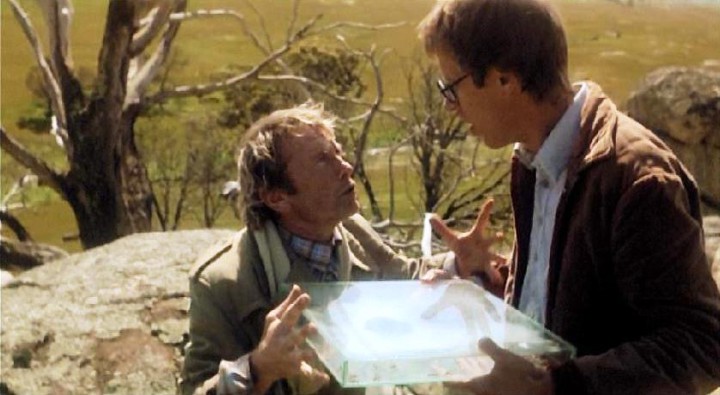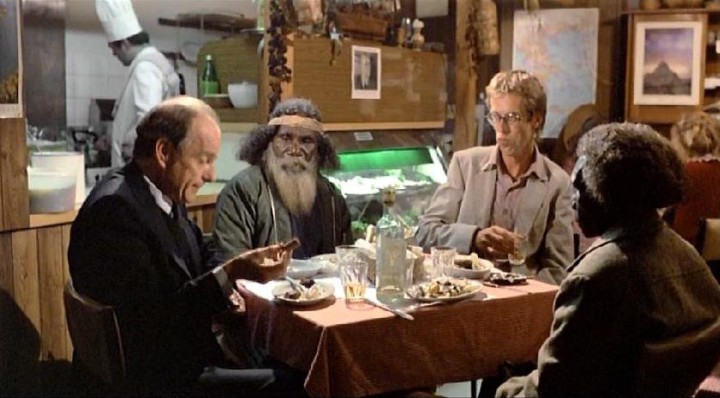Werner Herzog is one of cinema’s greatest puzzlements. So far as I can tell, he’s a major stylist with no particular style. He moves from picture to picture with no specific genre to claim. He dabbles in this and that. Somewhat preposterously, he sometimes turns his hand to documentaries. The preposterous aspect of that is that Herzog is perhaps cinema’s greatest liar. If film, to Godard, is “truth at 24 frames a second,” for Herzog, it’s more “lying at 24 frames a second.” In all honesty — since movies are meant to trick the audience in so many different ways — Herzog is probably nearer the mark. But consider his 2010 documentary (in 3D no less) Cave of Forgotten Dreams. Not only does he make such amazing — and rather charming — leaps as equating the flickering torch-lit images seen on the walls of caves with Fred Astaire’s shadow dance in Swing Time (1936), but by the end of the film, he’s off on a tangent about “albino crocodiles” — a tanget he adimitted was entirely made up.
So in the non-documentary, but often documentary-like, Where the Green Ants Dream (1984) it should come as no surprise that the supposed Aborigine mythology of the Green Ants was entirely invented by Herzog. This does not prevent him from presenting as factual, of course, but it certainly makes any claims the film might make to any anthropological value very doubtful indeed. Following the “logic” of the film, the whole thing seems to stem from a desire to cook up a story about strange weather occurences. (How much this was influenced by Peter Weir’s 1977 film The Last Wave would be interesting to know.) So what Herzog does is invent this scenario about a conflict between a mining company in Australia and a tribe of Aborigines, who are trying to protect the patch of sacred ground where the insects of the title are dreaming. According to Herzog’s myth, awakening the slumbering bugs will unleash all manner of natural disasters of the meteorological kind.
The story also gives Herzog free rein to cook up a legal fight between the two factions, which the Aborigines predictably can’t win. In the midst of all this we get often fascinating glimpses of Aborigine culture — maybe. After all, it’s foolish to assume any of this is true outside the recesses of Herzog’s mind. The idea of the lone survivor of a tribe who speaks a language no one can understand is intriguing (and it’s hard not to wonder if this isn’t a put-on for the white man), but is it true? Maybe. Maybe not. While Herzog is clearly on the side of the native culture, it’s hard to not realize that the line dividing his depiction of that culture and a lot of other pop culture transgressions isn’t very wide. How far removed some of this material is from Lon Chaney using magic tricks and giving the native chief kerosene to drink keep them in line in West of Zanzibar (1927) may not be all that far. All in all, this is minor Herzog — it almost feels like a doodle — with just enough in it to make it interesting as a Herzog movie.
Classic World Cinema by Courtyard Gallery will present Where the Green Ants Dream Friday, Sept. 19, at 8 p.m. at Phil Mechanic Studios, 109 Roberts St., River Arts District (upstairs in the Railroad Library). Info: 273-3332, www.ashevillecourtyard.com







Before you comment
The comments section is here to provide a platform for civil dialogue on the issues we face together as a local community. Xpress is committed to offering this platform for all voices, but when the tone of the discussion gets nasty or strays off topic, we believe many people choose not to participate. Xpress editors are determined to moderate comments to ensure a constructive interchange is maintained. All comments judged not to be in keeping with the spirit of civil discourse will be removed and repeat violators will be banned. See here for our terms of service. Thank you for being part of this effort to promote respectful discussion.